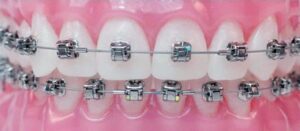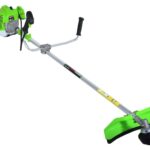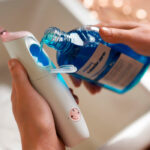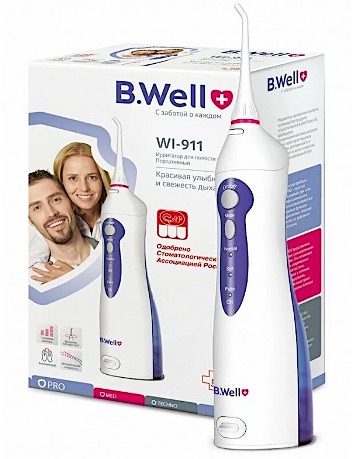How to choose an irrigator for braces: an overview of the basic requirements

An irrigator is a device for cleaning teeth from dirt, hard and soft deposits, plaque, and bacteria. Cleaning occurs by delivering a stream of liquid (this can be filtered water or a specialized oral product) under pressure. The liquid penetrates into the smallest crevices between the teeth and gums, literally washing away all the dirt from there.
If you have installed braces and are thinking about the need for a braces irrigator, then this article is for you. Next, you will find out whether an irrigator is required when wearing braces, the advantages of using an irrigator for the oral cavity, what types of irrigators there are, what models of irrigators are suitable for cleaning braces, how to properly brush teeth with braces with an irrigator.
Is it necessary to use an irrigator while wearing braces? Let us answer right away - no, it is not necessary to use an irrigator to clean braces. The irrigator does not affect the effectiveness of braces, therefore, if someone tells you that an irrigator is required when wearing braces under the pretext that “food gets stuck between the plates and wires, disrupting the shape and function of the braces, and the irrigator washes out these particles,” you don’t have to listen these people.
But if possible, it is recommended to use an irrigator. Firstly, even without braces, this is an effective way to get all the food particles out of the interdental spaces. Secondly, sometimes food actually gets stuck between the plate and the wire of the braces.This will not affect the efficiency, but the food stuck there will cause other inconveniences - it will begin to rot, affect the teeth, and a strong unpleasant odor will appear. The irrigator will clean them out from there.
The content of the article
What are the advantages of using an irrigator?
Irrigators are devices for effective cleaning of teeth and the entire oral cavity. What are their advantages? There are two main advantages here:
- Thoroughness with cleaning efficiency (the jet of liquid from the device penetrates into the cracks between the teeth and between the teeth and gums, that is, into those places where a regular brush cannot reach; from there, all plaque is washed away thanks to the adjustable power of the supplied jet).
- Multifunctionality (the irrigator can be used both for prevention - simple cleaning, and as a cleaning for braces and a medical device that disinfects, deodorizes or supplies medicine).
Additionally, it can be noted that the constant use of the device is compared to training for the gums - water is supplied to the gums, because of this they become stronger and bleed less.

Types of irrigators
There are two types of oral irrigators:
- Stationary. Large and powerful devices with a built-in open-type liquid reservoir. Its capacity is from 0.5 to 1 liter. They work from the mains and are connected via an outlet. The set comes with a large number of attachments. There is power and pressure adjustment. They make noise and vibrate more than mobile phones.
- Mobile. Small structures are distinguished by their size, light weight and compactness. There is a built-in closed water tank. Its capacity does not exceed 500 milliliters. Operates on batteries or its own batteries.The batteries need to be recharged once/twice a week when using the device daily.
Among the stationary ones, there are also professional ones - in general, these are the same irrigators, only with bigger and better functions. Such models are found only in clinics/dentists.
The best models of oral irrigators. If you decide to buy a irrigator for cleaning your teeth and/or braces, you might be wondering which irrigator is better to buy. Here are the top 3 best models:
- ACleon TF600. High build quality, lasts 3-5 years, cleans teeth thoroughly, water pressure is adjustable, has a warranty from the manufacturer, has an ultraviolet lamp inside for sterilization, comes with a large set of attachments included. The downside is that it is stationary and not suitable for travel.
- WaterPik WP-660 Aquarius Professional. Removes almost all deposits in teeth and crevices between them, high build quality, many positive reviews, the nozzle rotates, there is a timer, a set of attachments included, a large reservoir, high maximum power, there is adjustment of speed and pressure, specialized for cleaning braces/crowns. The downside is the high price.
- Panasonic EW 1211A. Portable, warranty from the manufacturer, small size, compact, there are three modes of operation, sound model, affordable price, supports wireless charging, high quality materials, in particular plastic, the battery lasts for 1.5-2 weeks of using the irrigator once a day, high maximum pressure of the supplied jet. The disadvantage is the small volume of the tank.
How to properly clean teeth and braces with an irrigator
Step-by-step instructions for use:
- Wipe down the model if it has been sitting idle for a long time.
- Connect the device to the network and turn it on if it is a stationary model.If portable, check the charge and turn it on.
- Fill the tank with filtered water or a specialized product.
- Check how the device works. Stand over a sink and place the irrigator head a short distance from your teeth and gums. Change the pressure until you find the right one.
- Lean over the sink and clean your braces first. Start with the far teeth. Move along the wire, stopping at each plate/lock for a few seconds.
- Proceed to brushing your teeth - move the handle along the gum line from tooth to tooth. You need to touch all the cracks. Pause on each side of the tooth for 2 seconds.
- Spit any water that accumulates in your mouth into the sink.
- Turn off the device, drain any unnecessary liquid from its container, if any.
- Rinse, wipe and dry the irrigator.



